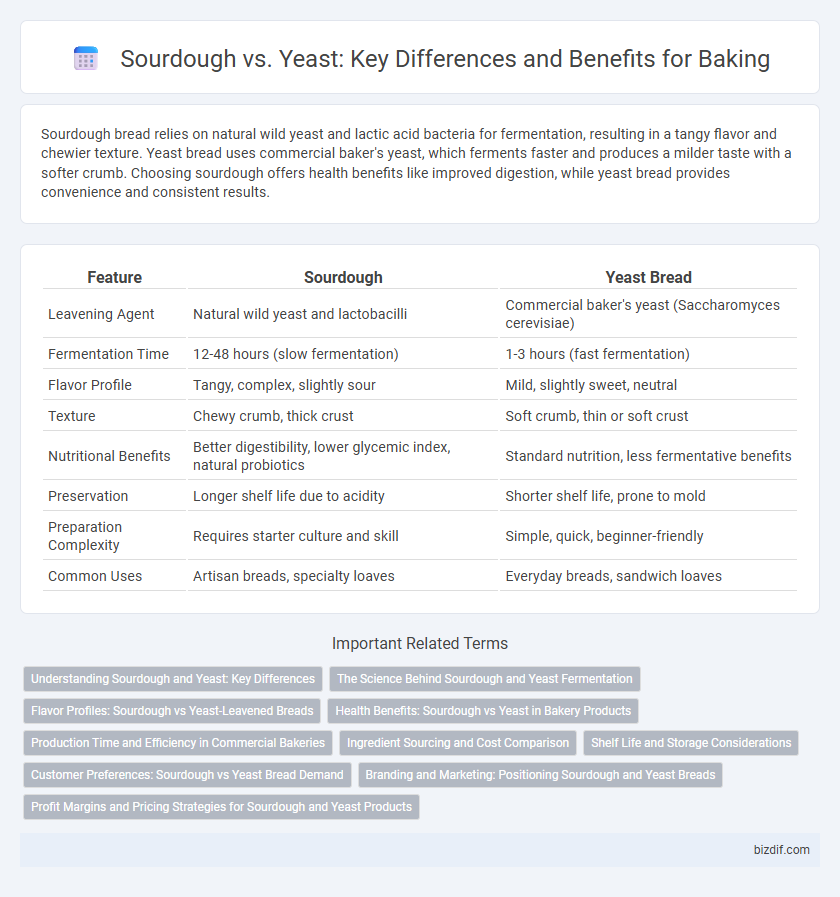Sourdough bread relies on natural wild yeast and lactic acid bacteria for fermentation, resulting in a tangy flavor and chewier texture. Yeast bread uses commercial baker's yeast, which ferments faster and produces a milder taste with a softer crumb. Choosing sourdough offers health benefits like improved digestion, while yeast bread provides convenience and consistent results.
Table of Comparison
| Feature | Sourdough | Yeast Bread |
|---|---|---|
| Leavening Agent | Natural wild yeast and lactobacilli | Commercial baker's yeast (Saccharomyces cerevisiae) |
| Fermentation Time | 12-48 hours (slow fermentation) | 1-3 hours (fast fermentation) |
| Flavor Profile | Tangy, complex, slightly sour | Mild, slightly sweet, neutral |
| Texture | Chewy crumb, thick crust | Soft crumb, thin or soft crust |
| Nutritional Benefits | Better digestibility, lower glycemic index, natural probiotics | Standard nutrition, less fermentative benefits |
| Preservation | Longer shelf life due to acidity | Shorter shelf life, prone to mold |
| Preparation Complexity | Requires starter culture and skill | Simple, quick, beginner-friendly |
| Common Uses | Artisan breads, specialty loaves | Everyday breads, sandwich loaves |
Understanding Sourdough and Yeast: Key Differences
Sourdough relies on natural fermentation using wild yeast and lactic acid bacteria, resulting in a tangy flavor and longer fermentation time, while commercial yeast involves cultivated strains for faster rise and consistent results. The wild yeast in sourdough contributes to better digestion and a richer nutrient profile compared to baker's yeast. Sourdough's complex microbial ecosystem creates a thicker crust and chewier crumb, distinguishing it from the simpler texture of yeast-leavened bread.
The Science Behind Sourdough and Yeast Fermentation
Sourdough fermentation relies on wild yeast and lactic acid bacteria that break down carbohydrates, producing carbon dioxide and organic acids which enhance flavor and texture. Commercial yeast fermentation uses Saccharomyces cerevisiae, leading to faster carbon dioxide production and dough rising but with less complexity in taste. The slow fermentation process in sourdough improves gluten structure and increases nutrient bioavailability, resulting in a distinctive tangy flavor and chewy crust.
Flavor Profiles: Sourdough vs Yeast-Leavened Breads
Sourdough breads develop complex, tangy flavors due to natural fermentation by wild yeast and lactic acid bacteria, creating a distinctive sour aroma and depth. Yeast-leavened breads typically exhibit a milder, sweeter taste with a softer texture, driven by commercial yeast's rapid fermentation process. The unique flavor profile of sourdough enhances crust crispness and crumb chewiness, while yeast breads provide a lighter and more neutral base ideal for various toppings.
Health Benefits: Sourdough vs Yeast in Bakery Products
Sourdough bread offers enhanced health benefits compared to yeast-leavened bread due to its natural fermentation process, which promotes beneficial probiotics and improves digestibility. The lactic acid bacteria in sourdough help break down gluten and reduce phytic acid, increasing nutrient absorption and making it a better option for individuals with mild gluten sensitivities. Yeast bread generally lacks these probiotic qualities and may cause quicker spikes in blood sugar levels, making sourdough a more heart-healthy and gut-friendly choice.
Production Time and Efficiency in Commercial Bakeries
Sourdough bread requires a longer fermentation period, typically ranging from 12 to 48 hours, which slows down production time compared to yeast-leavened bread that can be baked within 2 to 3 hours. Commercial bakeries prioritize yeast-based doughs due to their faster proofing and consistent rise, allowing higher throughput and scalability. While sourdough offers unique flavor and texture profiles, yeast enables more efficient operations and tighter production schedules in large-scale baking environments.
Ingredient Sourcing and Cost Comparison
Sourdough relies on naturally occurring wild yeast and lactic acid bacteria sourced from local environments, often requiring time and patience to cultivate a viable starter, which can reduce ingredient costs but increase labor expenses. Commercial yeast, typically Saccharomyces cerevisiae, is mass-produced and readily available, offering consistent fermentation rates at a lower upfront cost but potentially higher recurring expenses due to purchasing packaged yeast regularly. The cost comparison highlights that sourdough ingredients are often less expensive but involve indirect costs in preparation and maintenance, whereas yeast-based baking demands ongoing investment in commercial yeast supplies while providing faster, more predictable results.
Shelf Life and Storage Considerations
Sourdough bread has a longer shelf life than yeast bread due to its natural fermentation process, which inhibits mold growth and slows staling. Storing sourdough in a paper bag at room temperature maintains its crust, while yeast bread benefits from airtight storage to retain moisture but can become soggy. Refrigeration extends shelf life for both but risks drying out yeast bread faster than sourdough.
Customer Preferences: Sourdough vs Yeast Bread Demand
Customer preferences increasingly favor sourdough bread due to its perceived health benefits, such as improved digestion and lower glycemic index, driving demand in artisanal bakeries. Yeast bread remains popular for its consistent texture, quick production, and affordability, maintaining strong sales in mass-market bakeries. Market trends reveal a growing niche for sourdough varieties among health-conscious consumers, while convenience-driven customers continue to opt for yeast-based products.
Branding and Marketing: Positioning Sourdough and Yeast Breads
Sourdough bread is often branded as artisanal and health-conscious, appealing to consumers seeking natural fermentation and complex flavors. Yeast breads are positioned as convenient and consistent, targeting mass-market buyers who prioritize speed and affordability. Emphasizing the distinct qualities of each bread type helps bakeries effectively segment their audience and enhance product differentiation.
Profit Margins and Pricing Strategies for Sourdough and Yeast Products
Sourdough bread typically commands higher price points due to its artisanal appeal, longer fermentation process, and perceived health benefits, leading to elevated profit margins compared to yeast-based products. Yeast-based breads benefit from faster production times and lower ingredient costs, allowing for competitive pricing and higher volume sales. Strategic pricing for sourdough focuses on premium positioning and niche markets, while yeast bread pricing emphasizes affordability and mass-market accessibility.
Sourdough vs Yeast Infographic

 bizdif.com
bizdif.com